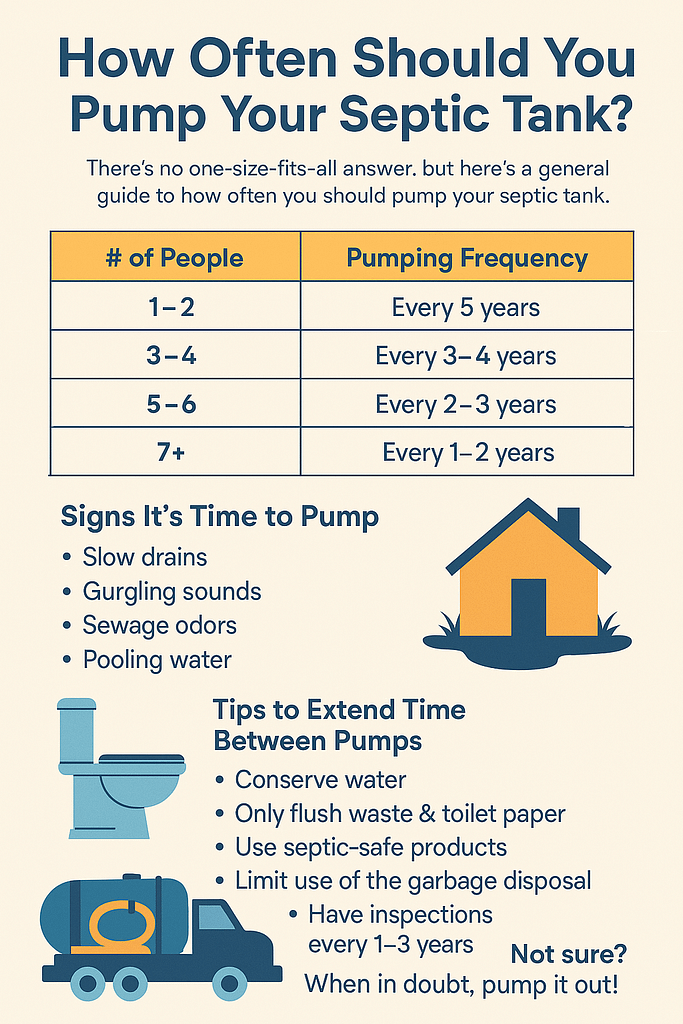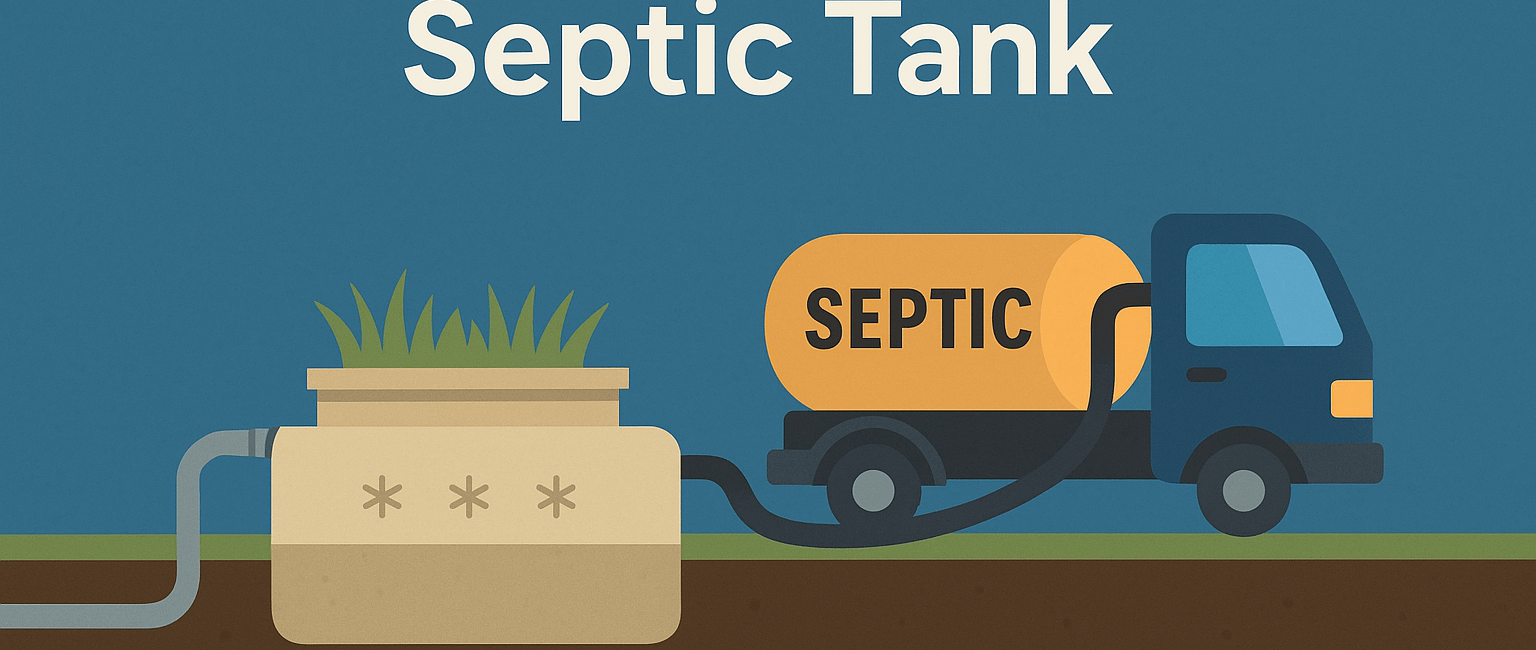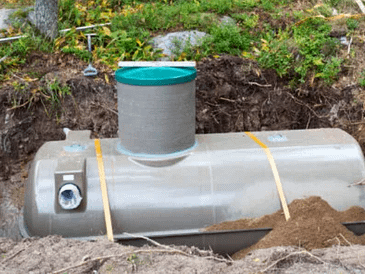Let’s face it: septic tanks aren’t exactly exciting to think about. They’re out of sight, out of mind… until something smells weird or backs up into your bathtub (ew).
If you’re wondering how often to pump your septic tank, you’re in the right place. This guide breaks it down by household size, water use, and a few other things you probably haven’t thought about. Because nobody wants to guess when their tank might blow—literally or figuratively.
“We went seven years without pumping and paid the price. Trust me—get on a schedule.” – Brian M., homeowner in Georgia
Why Pumping Your Septic Tank Actually Matters
Every time you flush, shower, or wash dishes, wastewater flows into your septic tank. Solids sink, grease floats, and the water in between filters into your drain field.
Over time, the sludge (aka solids) builds up. If you don’t remove it? It’ll overflow, clog your drain field, or back up into your house. That’s a $10,000 problem that a $300 pump could’ve prevented.
Quick Answer: How Often Should You Pump Your Septic Tank?
Here’s a simple guide based on household size:
| # of People | Recommended Pumping Frequency | With Garbage Disposal? |
|---|---|---|
| 1–2 people | Every 5 years | Every 3–4 years |
| 3–4 people | Every 3–4 years | Every 2–3 years |
| 5–6 people | Every 2–3 years | Every 1–2 years |
| 7+ people | Every 1–2 years | Annually |
📌 Tank size matters too. Most homes have 1000–1500 gallon tanks. If yours is smaller or you use a lot of water, bump up the frequency.
What Affects How Often You Should Pump?
Even if you live alone, you might need to pump more often if you:
- Run the dishwasher daily
- Have guests over a lot
- Take long showers (no shame!)
- Use a garbage disposal frequently
- Have a smaller septic tank
Your septic system is like a stomach—it can only handle so much before it gets upset.

How to Tell If It’s Time to Pump (Without Digging)
Don’t want to wait for a full-blown disaster? Watch for these signs your tank is due (or overdue):
- Slow drains (everywhere)
- Gurgling toilets
- Sewage smell inside or near the drain field
- Pooling water in your yard
- Exceptionally green grass over the septic area
- Water backing up into tubs or sinks (aka, Code Brown)
“Our shower started gurgling, and we thought it was a clog. Turned out the tank was full and pushing back. Disgusting, but fixable.” – Rachel D., Maine
Can You Go Too Long Without Pumping? Yes.
Skipping your septic service schedule is like ignoring oil changes for your car—except messier and way more expensive. If solids get into your drain field, you’re not just pumping anymore—you’re replacing parts of the system.
Cost to pump your tank? Around $250–$500.
Cost to replace a ruined drain field? $5,000–$15,000+.
Yeah… that calendar reminder doesn’t sound so bad now, does it?
Want to Stretch the Time Between Pumps? Here’s How:
✅ Use low-flow toilets and showerheads
✅ Spread out laundry loads through the week
✅ Ditch the garbage disposal (or use it sparingly)
✅ Don’t flush anything except toilet paper and human waste
✅ Keep grease, coffee grounds, and chemicals out of the drain
✅ Get your tank inspected every 1–3 years
These habits help your tank stay balanced—and your wallet stay full.
What Happens During a Septic Pumping?
If you’ve never had one done before, here’s what to expect:
- Access lids will be opened (some digging might be needed)
- A hose will vacuum out the solids and sludge
- The technician might inspect for cracks or damage
- You’ll get a receipt + notes on sludge levels and when to pump next
Whole process? Usually 30–60 minutes.
Messy? For them, yes. For you? Not really—unless it’s too late.
“The guy showed us the tank levels, and it was nearly at the top. We got lucky we pumped in time.” – Thomas R., Tennessee
Don’t Rely on Guesswork—Track It
- Write the date of your last pump somewhere handy (inside a cabinet, or in your phone).
- Ask your septic pro how full your tank was and when they recommend your next service.
- Schedule future pumps like you do for dental cleanings. Boring? Sure. But necessary? 100%.
Final Tip: When in Doubt, Pump It Out
If it’s been more than 3 years and you’re unsure of your tank size or usage—go ahead and schedule a pump. Worst case? You find out you could’ve waited another year. Best case? You dodge a nasty (and expensive) mess.
Need More Maintenance Tips?
Want to know how to treat your septic system right every day—not just when it’s full? Check out our full guide to babying your septic system for all the dos, don’ts, and signs of trouble.





